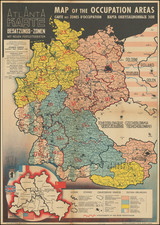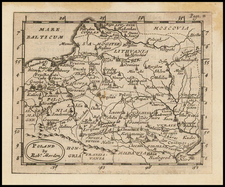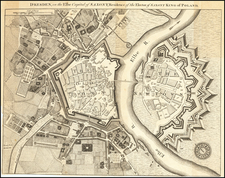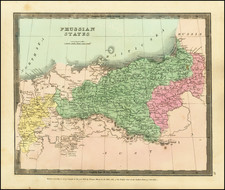Extremely rare separately issued map by Gerard Van Keulen, the third state of Johannes de Ram's map of the same title, published in 1690 (and much rarer than the 1st 2 De Ram maps).
The present example was part of the remnants of a Composite atlas of maps which was apparently assembled by Gerard Van Keulen in the early part of the 18th Century and included a few other extremely rare Van Keulen maps and a title page with Van Keulen's imprint.
We note only one reference to the map, which is listed as map #13 in a book entitled: Senieji Lietuvos žem?lapiai = Old Maps of Lithuania = Alte Landkarten Litauens: iš Vilniaus universiteto bibliotekos rinkini? / sudar?, aprašus pareng? Alma Brazi?nien?, Vilnius: Vaga, 1999. In addition, we believe the map also appeared in Paulus Swaen: Catalog 1986-1, A Selection of 700 Fine and Decorative Maps and Views, which listed the map as unrecorded.
The Van Keulens were a family of chartmakers and publishers. The firm, In de Gekroonde Lootsman (In the Crowned Pilot), was founded in 1678 by Johannes van Keulen (1654-1715). Van Keulen originally registered his business as a vendor of books and instruments (specifically cross-staffs). In 1680, however, he gained a privilege from the States of Holland and West Friesland for the publication of pilot guides and sea atlases.
In that year, van Keulen released his Zee-Atlas (Sea Atlas), which secured him a name in the competitive maritime publishing market. In 1681, he published the first volume of Nieuwe Lichtende Zee-Fakkel (New Shining Sea Torch). This would be the first of an eventual five volumes originally published between 1680 and 1684. A sixth volume was added in 1753. The Zee-Fakel won van Keulen lasting fame. The atlas had charts compiled by Claes Jansz Vooght and artwork from Jan Luyken. It proved immensely popular and was reprinted until 1783. There were translations in French, English, Spanish, and Italian.
The late-seventeenth century was an auspicious time to enter the maritime chart business. Previous industry leaders had either closed shop, died, or retired, leaving space for a new competitor. Van Keulen proceeded to buy up the stock and privileges of several maritime publishing firms; the most notable was the stock of Hendrik Doncker, acquired in 1693.
Johannes’ son, Gerard (1678-1726) took over the business upon his father’s death. Gerard was a skilled engraver and mathematician. His talents were noticed, as in 1706 he was named as Hydrographer to the Dutch East India Company (VOC).
In turn, Gerard’s son Johannes II (1704-1770) came to run the shop. He was also tied to the VOC, and his role as their chartmaker allowed his charts to be considered as quasi-official government documents. It is with access to formerly clandestine VOC geographic knowledge that Johannes the Younger was able to add a sixth volume to the Zee-Fakkel, which covered the East Indies. Johannes also continued to sell instruments, including the recently-invented Hadley’s Quadrant from 1744.
When Johannes II died in 1770, his widow ran the business in his stead, aided by her two sons, Cornelis Buys (1736-1778) and Gerard Hulst (1733-1801). Now a century old, the family business had extended to include an anchor factory. After Cornelis died in 1778, Gerard took on the management of the firm alone. He oversaw the introduction of sextants to their inventory and published the Dutch Nautical Almanac beginning in 1788. Annual editions appeared until 1885. Gerard also served as an original member of the Dutch Commission for Longitude at Sea from 1787.
Gerard’s widow ran the business for nine years after his death, when their son, Johannes Hulst, started to lead the firm in 1810. After his death in 1844, the firm passed out of family hands and into the control of Jacob Swert, a skilled cartographer who had worked for the business for two decades. He passed the work to his son, another Jacob, in 1866. By the mid-nineteenth century, the conversion from sail to steam had diminished the size of the market for charts. Fewer sailors needed fewer maps, charts, and instruments. In 1885, after 207 years in business, In de Gekroonde Lootsman closed its doors and auctioned its stock.












![[Daugavgriva] Die Haupt Vestung Dunamunder Schanz Welche die Saxen Anno 1700. Augustusburg nandten, aber Ao. 1701. auff Discretion wider auffgeben miessen.](https://storage.googleapis.com/raremaps/img/small/60087.jpg)

![[ Southern Ukraine / Mykolaiv Oblast / Kherson ] Die Otschakowische Tartarey Oder Westliches Nogaj Auc Jedistan](https://storage.googleapis.com/raremaps/img/small/102019.jpg)